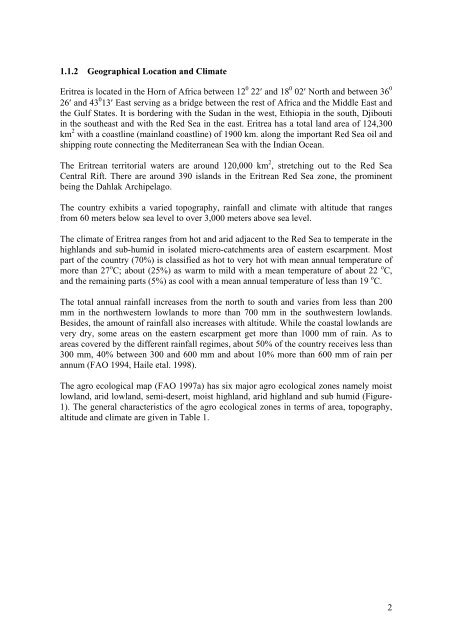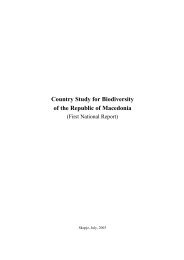English version - Convention on Biological Diversity
English version - Convention on Biological Diversity
English version - Convention on Biological Diversity
Create successful ePaper yourself
Turn your PDF publications into a flip-book with our unique Google optimized e-Paper software.
1.1.2 Geographical Locati<strong>on</strong> and Climate<br />
Eritrea is located in the Horn of Africa between 12 0 22′ and 18 0 02′ North and between 36 0<br />
26′ and 43 0 13′ East serving as a bridge between the rest of Africa and the Middle East and<br />
the Gulf States. It is bordering with the Sudan in the west, Ethiopia in the south, Djibouti<br />
in the southeast and with the Red Sea in the east. Eritrea has a total land area of 124,300<br />
km 2 with a coastline (mainland coastline) of 1900 km. al<strong>on</strong>g the important Red Sea oil and<br />
shipping route c<strong>on</strong>necting the Mediterranean Sea with the Indian Ocean.<br />
The Eritrean territorial waters are around 120,000 km 2 , stretching out to the Red Sea<br />
Central Rift. There are around 390 islands in the Eritrean Red Sea z<strong>on</strong>e, the prominent<br />
being the Dahlak Archipelago.<br />
The country exhibits a varied topography, rainfall and climate with altitude that ranges<br />
from 60 meters below sea level to over 3,000 meters above sea level.<br />
The climate of Eritrea ranges from hot and arid adjacent to the Red Sea to temperate in the<br />
highlands and sub-humid in isolated micro-catchments area of eastern escarpment. Most<br />
part of the country (70%) is classified as hot to very hot with mean annual temperature of<br />
more than 27 o C; about (25%) as warm to mild with a mean temperature of about 22 o C,<br />
and the remaining parts (5%) as cool with a mean annual temperature of less than 19 o C.<br />
The total annual rainfall increases from the north to south and varies from less than 200<br />
mm in the northwestern lowlands to more than 700 mm in the southwestern lowlands.<br />
Besides, the amount of rainfall also increases with altitude. While the coastal lowlands are<br />
very dry, some areas <strong>on</strong> the eastern escarpment get more than 1000 mm of rain. As to<br />
areas covered by the different rainfall regimes, about 50% of the country receives less than<br />
300 mm, 40% between 300 and 600 mm and about 10% more than 600 mm of rain per<br />
annum (FAO 1994, Haile etal. 1998).<br />
The agro ecological map (FAO 1997a) has six major agro ecological z<strong>on</strong>es namely moist<br />
lowland, arid lowland, semi-desert, moist highland, arid highland and sub humid (Figure-<br />
1). The general characteristics of the agro ecological z<strong>on</strong>es in terms of area, topography,<br />
altitude and climate are given in Table 1.<br />
2
















